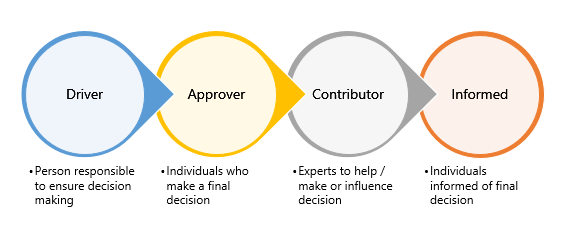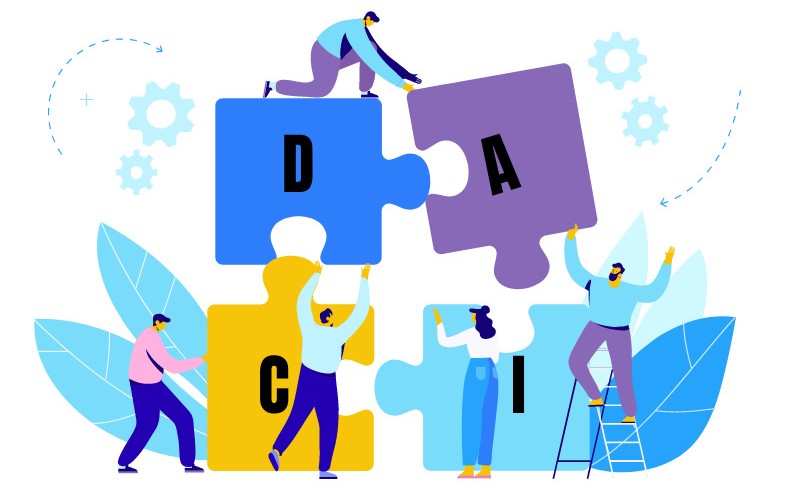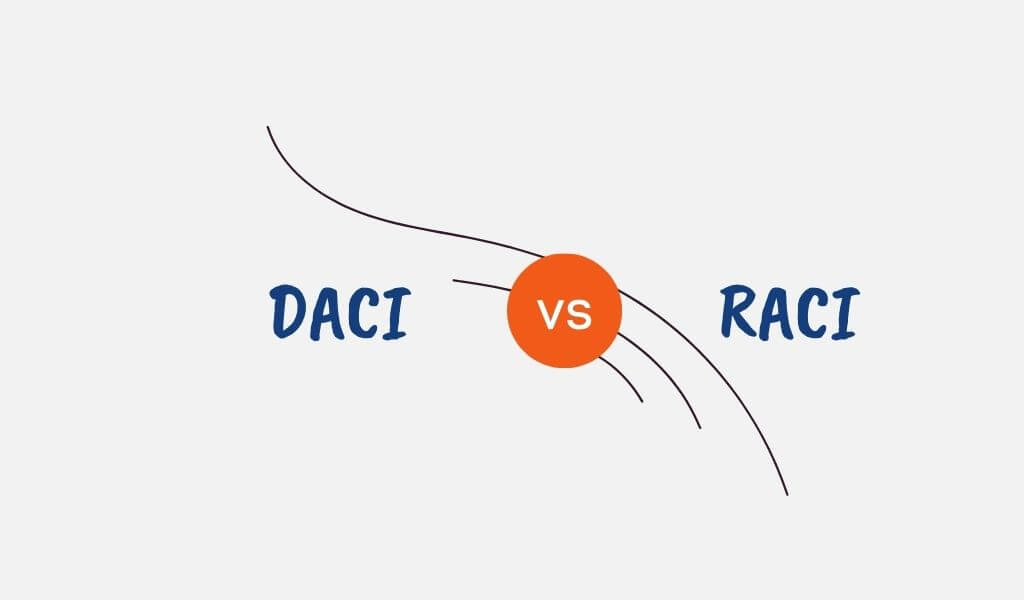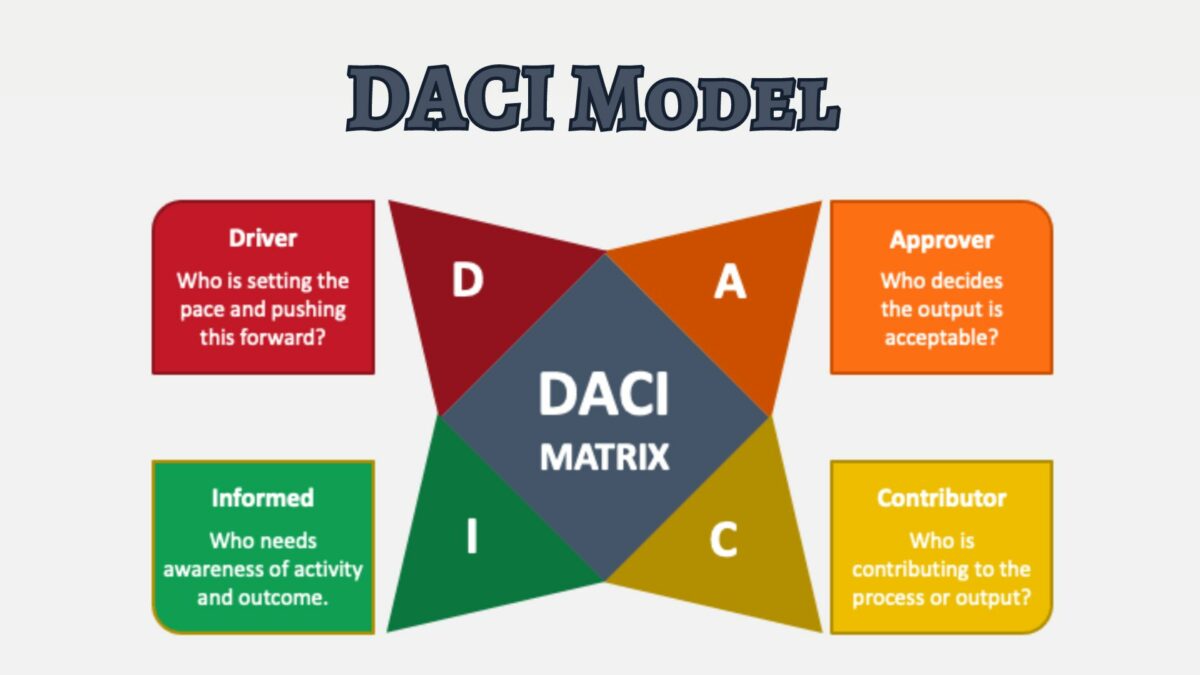DACI Model in Project Management: An In-depth Guide to Improved Project Management
Looking to supercharge your project management skills? The DACI model could be just what you need. This decision-making framework is designed to streamline your project processes, eliminating misunderstandings in task distribution and promoting team collaboration. With this model, you’ll find meeting project requirements becomes a breeze. It’s a tool that helps your team meet deadlines and exceed stakeholder expectations. Plus, it fosters a sense of unity, with no class division in task assignments. So, if you’re ready to take your projects from good to great, let’s dive into the benefits and applications of the DACI model.
What is the DACI Model?

The DACI model is a decision-making structure that bolsters project management by clarifying accountability and improving communication. The name, DACI, is an acronym representing four fundamental roles in the project decision-making process: Driver, Approver, Contributor, and Informed.
Driver (D)
The Driver embodies the heart of the DACI chart and strategy. As the project’s leader, they are the person steering the decision-making process. They work to exceed stakeholder expectations by efficiently coordinating group recommendations and managing smaller tasks within the project. Being the Driver could mean holding positions such as the chief technology officer, project managers, or team leaders.
Approver (A)
The Approver is a critical role in the DACI model. This person has the final say in project decisions, offering an unbiased perspective. Typically, the Approver is a senior-level leader like a departmental manager or CEO. Although some organizations might entertain more than one Approver, it’s generally recommended to keep just one to prevent confusion. An Approver’s commitment to a project includes sanctioning decision-making documents, retaining the right to approve or reject decisions, and providing comments and feedback during the approval process.
Contributor (C)
Contributors are team members who present knowledge and expertise to inform the decision-making process in the DACI matrix. They are the ones supplying supporting information critical to the decision at hand. Whether they’re part of the marketing, sales, or support teams, these contributors use their specialized skills to aid in effective teamwork and successful project completion.
Informed (I)
The Informed role in the DACI framework includes individuals who aren’t directly involved in the decision-making process but will be affected by its outcome. These team members need to be kept updated on decisions as their work may require adjustments based on the results. The Informed group is crucial for ensuring all teams understand decisions made, promoting a more holistic, unified approach to project management.
What is the DACI decision-making framework?
As you delve deeper into project management methodologies, you’ll inevitably encounter the DACI framework. With the context rooted in the 1980s, it was formulated by a software company, Intuit. Its development aims to streamline and structure decision-making processes within teams, alleviating any ambiguity regarding responsibilities. It defines and distinguishes four key roles: the Driver, Approver, Contributor, and Informed.
| DACI Framework | Description
|
|---|---|
| Driver | Leads the project |
| Approver | Makes final decisions |
| Contributor | Provides expertise |
| Informed | Stays updated |
You’re well on your way to fully understanding the power and potential behind the DACI model. Remember, the DACI model isn’t just about separating roles; it’s about maximizing the strengths, skills, and knowledge of your team members. By well-defining each role, teams are guided smoothly through the decision-making process, preventing bottlenecks and confusion often caused by overlapping roles.
DACI Decision-Making Framework: Where & When To Use

The DACI framework isn’t a one-size-fits-all model. The decision to adopt this model in your project isn’t trivial — each project’s unique nature determines the suitability of the DACI framework. Below are scenarios where utilizing the DACI decision-making model could really make a difference.
In Complex Projects
Complex projects can be particularly challenging to manage due to their many moving parts. The hierarchical structure of the DACI framework, distinguishing the roles of Driver, Approver, Contributor, and Informed, proves beneficial in such settings. The framework ensures efficient task allocation, deadline management, and goal setup, relieving a lot of stress linked with decision-making in such projects. When roles are well-defined, barriers in communication are minimized, and each team member’s skills and knowledge are optimally used.
For Cross-Functional Teams
For cross-functional collaborations where members are from diverse domains within the organization, the DACI model clears ambiguities on individual responsibilities and roles. It underlines collaboration and communication, essential elements for the fruitful synergy of cross-functional teams. It brings team members on the same page, clarifying what is expected from each role, ensuring a smooth decision-making process.
During Rapid Growth or Scaling
In the face of growth or scaling, decision-making can become chaotic and unclear due to the dynamic change in team structure. The DACI model provides a structure in this chaos, ensuring that decision-making is streamlined and efficient. It’s designed to plug pitfalls in decision-making during rapid growth, creating clarity and transparency in roles even amidst organizational shifts.
When Streamlining Decision Processes
Streamlining decision processes is a burning need where the decision-making has been identified as inefficient or unclear. The DACI framework is a fantastic solution in such cases. With clear hierarchies and defined roles, decision-making gets more efficient, and roadblocks in the process are eliminated.
The implementation of the DACI model has various benefits across different projects and teams. It’s a proven ally for project managers and teams, blessing them with a smooth, efficient, and successful project execution. Keep in mind these scenarios when you face bottlenecks in project management — adopting the DACI framework might just be the solution you need.
Why is the DACI Model so Effective?
Understanding the DACI model can be a game changer when striving to enhance your project management skills. If you’re wondering why this is, delve deeper into its impressive benefits.
- The DACI framework acts as a lifeline. Everyone in the team knows their role and the expectations tied to it. This clarity prevents misunderstanding and promotes team collaboration.
- Its RACI matrix explicitly includes the decision-maker role. While in a RACI vs DACI comparison, both models help define roles within a team, the DACI’s focus on highlighting the ultimate decision maker provides better clarity and decision-making authority.
- Further, the DACI model prioritizes efficient communication, which is a boon during rapid growth or scaling of projects. Efficient communication reduces the chances of miscommunication.
- Another significant benefit of the DACI framework is its potency in aiding project completion within set deadlines. Thus, unlike in a RACI vs DACI scenario where the timeline depends on a consensus, the DACI ensures that task division and deadlines are met without fail.
- Finally, the DACI model nurtures an atmosphere of equality among team members. There’s no place for class division since everyone has a clear understanding of their respective roles and contributions.
Benefits of Using the DACI Framework In Project Management
Implementing the DACI framework for project management can boost the efficiency of your projects. Here, we’ll examine some key benefits of using the said framework.
1. Promotes Team Collaboration
One of the main advantages of the DACI model is its ability to strengthen team cooperation. When properly implemented, DACI helps to ensure that everyone’s role within a project is defined clearly. This structure promotes open communication- a vital aspect of successful collaboration. Team members can collaborate more seamlessly, brainstorm innovative solutions for complex problems, and keep each other accountable. Moreover, the inclusive nature of DACI provides a learning opportunity for new team members, allowing them to gain experience from senior members.
2. Avoid Misunderstandings Among Team Members
Misunderstandings of roles and responsibilities can lead to confusion and inefficiency in project delivery. Such mishaps are avoided through the DACI framework’s clear role designation. Each team member understands their standing on the DACI chart, whether as a Driver, Approver, Contributor, or Informed. Everyone knows what they should do, minimizing chances of task duplication or omission- both could be detrimental to a project’s execution.
3. Helps Teams Meet Project Requirements
The DACI model showcases its effectiveness when it comes to meeting project requirements. The framework’s stringent role classifications ensure that the fittingly equipped team members oversee all aspects of the project. Since the DACI Matrix identifies the decision-makers and the contributors, it guarantees that tasks align with the project’s objectives and are executed efficiently. The organization and structure provided by the DACI framework allow teams to work more effectively, completing projects within established deadlines with minimized hiccups.
Drawbacks of the DACI Decision-Making Framework
While the DACI framework is a powerful tool for facilitating project success, it’s not without its drawbacks. This section’ll walk you through potential issues you might encounter when applying this model.
1. Potential for Role Confusion
Though the DACI model clearly differentiates between the roles of the Driver, Approver, Contributor, and Informed, confusion can still arise. The extensive collaboration it encourages can blur lines, masking who holds what responsibility. Consequently, this can lead to misunderstandings about the scope of everyone’s roles within the project.
2. Risk of Over-Reliance on the Driver
Use of the DACI framework can inadvertently create an over-reliance on the Driver. Though it’s important that this role drives decision-making, the team might mistakenly perceive the Driver as the sole decision-maker. This predisposition can limit decision ownership, diminishing the sense of collective responsibility.
3. Possible Delays in Decision-Making
Wherever differing opinions are held, reaching a consensus can be challenging and time-consuming. Decision-making delays are, therefore, a risk, particularly when team members’ perceptions towards the suggested solution vary. Delays can push back project deadlines, affecting overall execution timelines.
4. Exclusion of Broader Team Perspectives
While the DACI model is inclusive, it can run the risk of not fully representing all perspectives within a group. Someone’s role may restrict their input options or opportunities. For example, an ‘Informed’ team member might have valuable ideas but may lack a platform to express them, potentially sidelining innovative concepts.
5. Misalignment with Organizational Culture
The adaptability of the DACI matrix to fit within various organizational cultures is crucial. Its rigidity or perceived complexity may not gel with all teams or working environments. Instead of boosting productivity, it might serve as an obstacle, enforcing unnecessary structure. This clash can hinder rather than aid project progress.
Overall, while the DACI framework brings a host of benefits to project management, it’s essential to understand the potential challenges. Awareness of its limitations helps in devising strategies to effectively use the DACI chart for successful project outcomes.
DACI vs RACI

When optimizing project management, it’s crucial to consider various approaches. The popular frameworks are DACI and RACI. Both provide a structure for roles and responsibilities, promoting efficiency and accountability. Understanding each framework’s strengths and purposes can truly optimize your project management.
What is the DACI Framework?
The DACI framework, characterized by the roles of Driver, Approver, Contributor and Informed, offers a clear delineation of job duties. It’s particularly effective in enhancing decision-making processes. By using the DACI model, you can avoid ambiguity and improve your team’s communication, efficiency, and progression through projects.
Remember, each letter in DACI represents a different project role:
- Driver
- Approver
- Contributor
- Informed
The drawback? It could lead to role confusion or over-reliance on the Driver position. This could delay decision-making and even exclude valuable perspectives, which is why understanding these limitations is integral to effective implementation.
What is the RACI Matrix?
Then there’s the RACI matrix, utilized mainly in human resources planning and day-to-day project management, especially for complex, large-scale projects. Compared to the DACI model, the RACI chart outlines individual roles and delegates responsibilities to team members.
In the RACI model, the letters stand for:
- Responsible
- Accountable
- Consulted
- Informed
Choosing between the DACI and RACI often depends on your specific goals. If you seek to improve the decision-making process, the DACI model emerges as the front runner. However, the RACI matrix proves its worth for clarity in roles and accountability.
Which One is Better?
With an understanding of both the DACI and RACI frameworks, you’re equipped to make sound choices for your projects, leading to better communication, decreased ambiguity, and, ultimately, more successful outcomes. But let’s note it’s not a one-size-fits-all approach and should align naturally with your organizational culture.
Conclusion
DACI and RACI models can be game-changers in project management. They’re buzzwords and practical tools to streamline your team’s roles and responsibilities. Remember, RACI shines in complex tasks, while DACI excels in swift decision-making scenarios. Plus, there’s RASCI, adding an extra layer of support to your project’s structure. By implementing these models, you’re setting up your project for success. It’s all about enhancing communication, reducing confusion, and aligning goals.
Frequently Asked Questions
Q1. What is a DACI model?
The DACI model is a decision-making framework used in project management. Its acronym stands for Driver, Approver, Contributor, and Informed, indicating the roles essential in making critical decisions in a project.
Q2. Is the RACI model outdated?
While some may argue that the RACI model is outdated due to its focus on traditional, command-and-control work environments, it remains relevant for complex tasks requiring clearly defined responsibilities. Though it may not fit all modern work environments, it continues to be effective for many.
Q3. How do you use a DACI model?
Implementing the DACI model involves identifying the Driver, Approver, Contributor, and Informed for each decision to be made within a project. Each person understands their role, enhancing clear communication and effective decision making.
Q4. How are the DACI and RACI models different?
While both DACI and RACI are management frameworks, they serve different purposes. DACI focuses on decision-making roles within a project, while RACI concentrates on task responsibilities. Essentially, RACI maps out who does what, and DACI determines who decides what.
Q5. Can I use DARE instead of the RACI model?
Yes, DARE is a viable alternative to the RACI model. DARE stands for Decide, Advise, Recommend, and Execute, providing a clear framework for defining roles connected to decision-making and execution in a project. As with any framework, choosing between DARE and RACI depends on the specific needs of your project.

Leave a Reply